Green Schools 2017
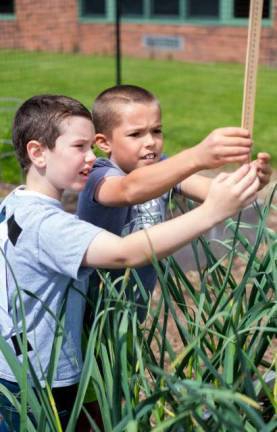
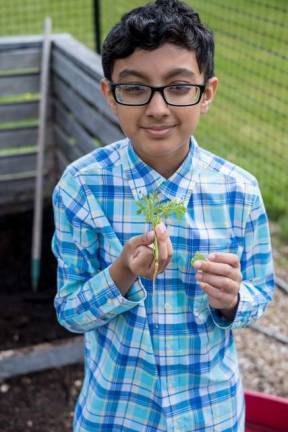
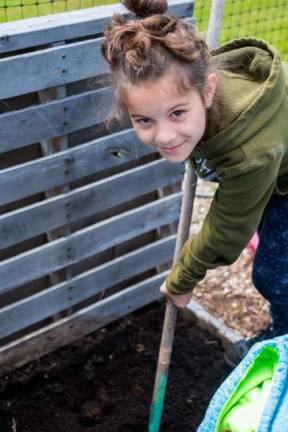
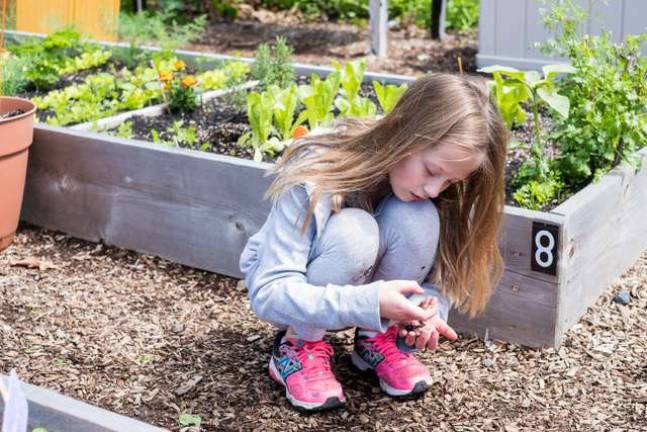
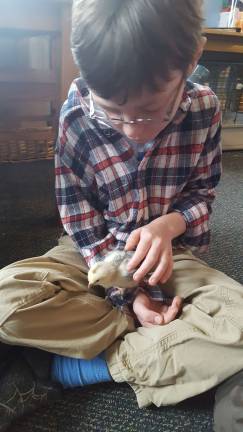
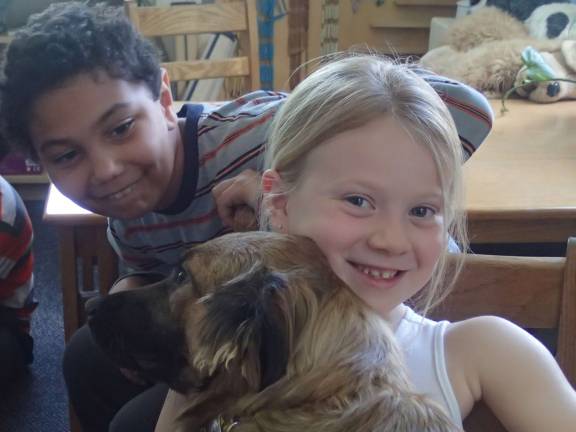
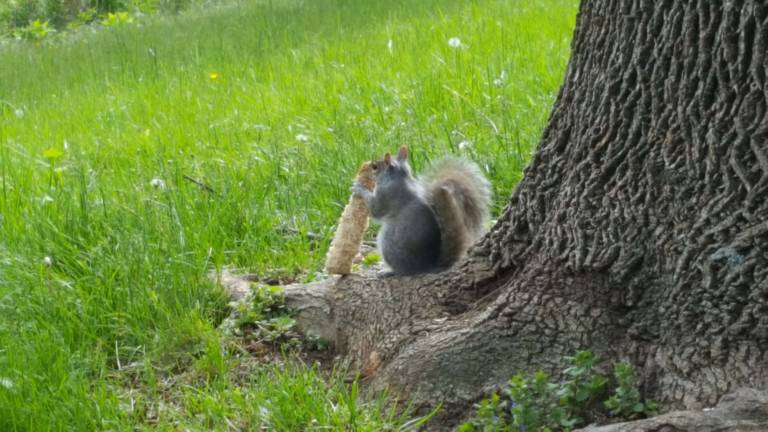
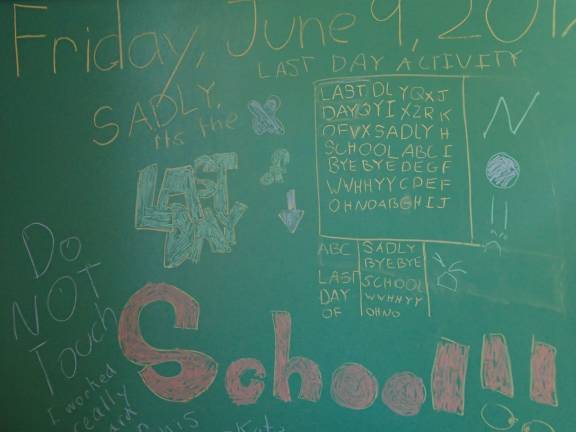
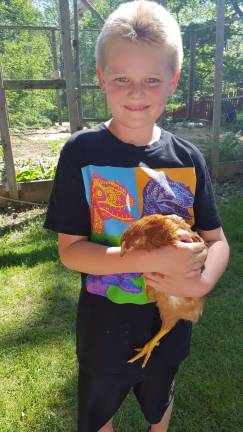
This year’s survey was full of good news...
94% of schools reported meaningful
outdoor learning experiences for students
78% use their grounds for ecologically beneficial uses
such a school vegetable garden or native plant habitat
67% have initiated efforts to improve
student nutrition and fitness
56% have decreased water consumption in the last 5 years
There’s always room for improvement...
39% supply sufficient bike racks
44% of school cafeterias serve fresh local food
56% do not use any renewable energy
Profile: Pine Tree Elementary, Monroe NY
Fresh picked haiku
In its third year, Pine Tree Elementary School’s garden is going gangbusters. The charming, kid-tended plot is not only pumping out food, which gets used in the cafeteria and sent home with families, but also inspiration.
Toni Leone, a gifted and talented teacher and the force behind the garden, invited Dirt to tag along on a haiku walk with her creative writing class. A haiku walk, explains Jack Kehnle, 9, is when you “go outside in nature, walk around and try to find things to help you make a haiku.”
Haiku are supposed to contain a certain number of syllables in each of their three lines, but there are more subtle elements to the poetry form, explains Leone, as we step out of the computer lab and into the bright mid-morning sun. Like the “turn of thought” in the third line.
In the first two lines of a haiku you’re sketching from nature, Leone explains, and then, without trying too hard, in the third line you infer the moral.
Here’s a haiku one of Leone’s students wrote that nails it:
Hard neck garlic grows
Withstands the winter weather
Patience still matters
Out in the garden, the students mill about, planting carrot seeds, tasting dill, and digging in the compost for earthworms (which have five hearts, I am told).
“Sometimes I’m like, why don’t I have three hearts!,” wonders Ayanna Wilson, 10.
A couple pairs of kids sit on benches, writing in notepads. Voices pipe up now and then: “Mrs. Leone, is this a turn of thought?”
“I’m about to finish one. I’m trying to get a turn of thought,” says Kehnle. A minute later he leaves his notebook on the bench, to go off and measure garlic with another boy (see cover). Leone picks the notebook up and reads what he’s written:
I see a spider
Walking gracefully through soil
So many species
Is it a turn of thought? Sounds like one to me.
“You ask a Westerner, they’ll agree,” Leone nods. “I don’t know about the Japanese. They’re tricky.”
Leone joins a cluster of children examining a rogue dandelion. How did it get into this raised bed? They tick off different methods of seed dispersal: Wind. Water. Animals. Seed pod explosion. They decide to leave the dandelion, full of conversation potential.
That part about not trying too hard – the key to a good haiku – strikes me as the essential ingredient here, too. These kids are not stressing, but they are most certainly learning.
The second graders study beneficial bugs in the pollinator garden. Third grade just released their Painted Lady butterflies, and planted tomato and pepper transplants.
Everyone’s catching the gardening bug, teachers included. “That’s how I keep my head on straight,” said third grade teacher Kate Wulff, whom I bumped into in the hallway. “It’s like, ‘Let’s go to the garden, everybody.’ We go there and breathe.”
It took Leone multiple tries to secure her first grant: $2,500 from the Whole Kids Foundation. She might not have gotten it at all had not the PTA jumped in and bought the fencing and the cedar for the raised beds. But once the garden got some momentum, things started to fall in line. It was easy to get the next grant, $500 from Tractor Supply. 4-H students built benches. Girl Scouts bought two additional benches with $150 raised from cookie sales, creating an additional outdoor teaching space just outside the garden. The school social worker, who used to play board games with small groups of students, now uses that time to paint garden signs. Parents have stepped up, volunteering to help Leone tend the garden over the summer, when the produce goes home with ESL and summer school students (most school gardens wither in the summer.)
Some days, the students see the fruits of their labor in the cafeteria. There are 900 kids in the building, so it’s usually in a side dish or as a garnish, maybe the cilantro in the Spanish rice, or tomatoes in a salad.
“Whatever she brings, we use,” said Maria Collins, the cook manager of Pine Tree. “It’s great.” Collins places signs next to dishes that include garden produce. “The kids know with the signs,” said Collins. “They’ll come and say: ‘Are these our tomatoes?’”
Collins and Leone share an open line of communication. Collins prefers hardier varieties of lettuce, for instance, so now that’s what’s growing in the garden.
The two women also have something else in common. You could call it added incentive. Leone is a mother of a Pine Tree student, and Collins is a grandmother of one.
Profile: Fields of Green Montessori, Vernon NJ
Where animals are teachers
Don’t be alarmed, says Debra Smorto, if a squirrel climbs up you. We are headed out to see the chickens, goats and garden at Fields of Green Montessori.
I appreciate the heads’ up, I tell Smorto, the school’s owner and director. I might have been alarmed.
The 65 kids here are accustomed to animals everywhere. They know that if Scout the squirrel climbs up you, just stay still and she’ll go up and down. She’s just “saying hi.” (Well, she’s actually looking for food.)
We do not encounter Scout, which was taken in by Smorto after it sustained head injuries falling out of its nest. But we do meet a regular Noah’s Ark of creatures: at least 17 indoor pets, by my count. Two rescue dogs, Pheona and Ailish, a White Swiss Shepherd a Shepherd/Golden Retriever mix, hang out with the kids every day. There’s a rabbit named Ebony and three guinnea pigs that Smorto’s granddaughter got at a carnival – Popcorn, Kettle Corn and Kernel. In addition to running this school, Smorto is a wildlife rehabilitator, and everyone in town knows it.
In the toddler room are the quiet birds, a pair of zebra finches, since toddlers make enough noise on their own. Three cockatoos, two parakeets and an Eclectus parrot are perched in cages around the main room. There’s a worm bin on the floor for composting food scraps.
One of cockatoos, Sunny, is the classroom ambassador because he can talk: “Pretty bird, pretty bird.” The birds are often allowed to fly free, but today is a special and slightly hectic half-day: the last day of school. On the blackboard is a message chalked by a student. “Sadly, it’s the last day of school!!”
If that sounds like an oxymoron, it may have something to do with the menagerie of creatures here. The animals help the kids’ emotional state, said Smorto. “Kids can work on the floor and pet the dog at the same time. It’s not a sterile situation. When kids are comfortable, they learn,” she said. Their presence relieves stress, especially for kids who have come here after having had problems at public school.
Caring for pets also teaches invaluable lessons in compassion and responsibility, Smorto said. On a rotating chore chart that hangs on the wall, each child is paired with an animal to care for and a cleaning job. The older kids collect the hens’ eggs daily, which they sell to the school families. Forgetting to feed a pet, they learn, would be like if your parents just didn’t give you any dinner.
Then there are the unscripted, real-world lessons that you pick up from observing the natural world. When the female parakeet started beating up on the male, for instance, they had to be put in different cages. Smorto used the opportunity to discuss separation, which some kids are familiar with from home. Sometimes when people are fighting, they have to go away from each other for awhile.
Are they going to get divorced? The kids wanted to know.
As it turned out, after a couple weeks in neighboring cages, River and Blue Sky were able to work it out. Now they’re back together.
What other schools said...
We compost all food in our cafeteria. A local farmer from the Drew Farm comes to take our composting on a daily basis. All other trash is recycled. Plastic drink pouches are mailed to Capri Sun.
Principal Rosemary Gebhardt
Walnut Ridge Primary School, Vernon NJ
We learn a great deal by raising vegetables. We use our garden’s produce for our cafeteria, cooking classes and community programs.
Principal Frank Maendel
Bellvale School, Chester NY
School cafeteria has seasonal ‘Jersey Fresh’ events featuring local produce and district has moved toward incorporating local organic meats.
Principal Stuart Stumper
Rolling Hills Primary School, Vernon NJ
We hatch butterflies and praying mantises and then let them go outside. We go to the local parks to hike and also did an activity with every student where they planted recyclables and items that are not recyclable in socks. We will unearth these items in June.
Principal Sandra Wood
Park Avenue Elementary, Warwick NY